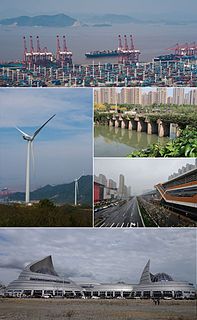 W
WBeilun District (help·info) is a district of Ningbo in Zhejiang province, China. It is dominated by Beilun port, an international port of the easternmost edge of the southern coast of Hangzhou Bay. It primarily services the regional city of Ningbo. Beilun district has 380,000 permanent residents and 850,000 residents. Beilun district has a land area of 615 square kilometers, a sea area of 258 square kilometers and a coastline of 150 kilometers. It is the largest sea area and the longest coastline area within the jurisdiction of Ningbo city.
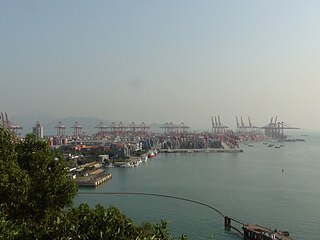 W
WChiwan is a bay area surrounded by Chiwan hill at the east, Xiaonanshan hill at the north, and Ying Zui hill at the southeast, in Nanshan district, Shenzhen, China.
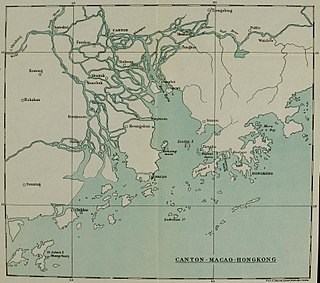 W
WCumsingmoon or Jinxingmen is an anchorage in Zhuhai, Guangdong, on the southern coast of China, within the Pearl River estuary and close to the former European colonies of Macao and Hong Kong.
 W
WFuyong Ferry Terminal, also known as the Shenzhen Airport Ferry Terminal, is a ferry terminal on the shore of the Pearl River, located in the Fuyong Subdistrict of the city of Shenzhen, next to Shenzhen Bao'an International Airport. Passengers have to clear China Immigration at this terminal before heading for Shenzhen Airport; however, they can obtain a 24hr transit at dock when heading for International flights.
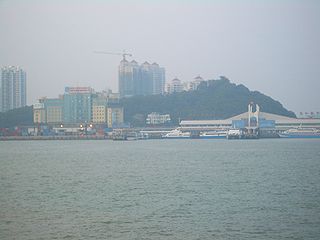 W
WThe Port of Zhuhai is the port of the prefecture-level city of Zhuhai, on the west side of the Pearl River estuary in the Chinese province of Guangdong. The Port of Zhuhai is composed of seven main port areas: Gaolan, Wanshan, Jiuzhou, Xiangzhou, Tangjia, Hongwan and Doumen. The main areas are the Jiuzhou Port Area to the east of the city, and the Gaolan Port Area to the west. As of 2012, the port had 131 berths, 126 production berths, of which 17 were deep-water berths over 10,000DWT.
 W
WLanshan port is a large bulk loading and discharging port located in Shandong, China. It is situated in the yellow sea midway between Rizhao and Lianyungang, and adjacent to Haizhou bay.
 W
WLüshun Port in Lüshunkou District, Dalian, Liaoning province, China, refers to the original Lüshun Naval Port for military use or the New Lüshun Port for commercial use. The port was known in colonial times as Port Arthur.
 W
WThe Port of Nanjing is located in Nanjing, Jiangsu Province, China, and is the largest inland port in the world, with throughput reaching 191 million tons of cargo in 2012. Nanjing Port has a long history reaching back to A.D 229, when it became a major seaport. It is situated in the lower reaches of the Yangtze River, just before the start of the Yangtze Delta. The Port has authority over 208 km of Yangtze River shoreline, 110 km in the North Shore and 98 km in the South Shore. As of 2010, it operated six public ports and three industrial ports.
 W
WThe Port of Dalian founded in 1899 lies at the southern tip of Liaodong Peninsula in Liaoning province and is the most northern ice-free port in China. It is also the largest multi-purpose port in Northeast China serving the seaports North Asia, East Asia and the Pacific Rim. It is the trade gateway to the Pacific. It is the second largest container transshipment hub in mainland China.
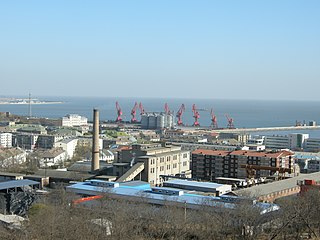 W
WThe Port of Huludao is an artificial deep-water international seaport on the coast of Huludao, Liaoning, People's Republic of China, on the Liaodong Bay. It is one of several smaller ports being rapidly expanded in Liaoning Province in order to service the Northeast.
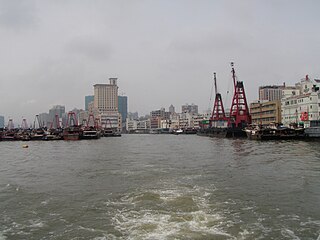 W
WThe Port of Macau is the seaport of Macau, China.
 W
WThe Port of Xiamen is an important deep water port located on Xiamen Island, the adjacent mainland coast, and along the estuary of the Jiulongjiang River in southern Fujian, China. It is one of the trunk line ports in the Asia-Pacific region. It is ranked the 8th-largest container port in China and ranks 17th in the world. It is the 4th port in China with the capacity to handle 6th-generation large container vessels. In 2013, Xiamen handled 191 million tons of cargo, including 8.08 million TEUs of containers. On 31 August 2010, Xiamen Port incorporated the neighboring port of Zhangzhou to form the largest port of China's Southeast. This was a relatively uncommon case of ports merging across jurisdictions.
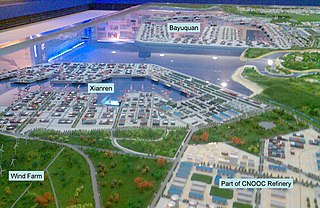 W
WThe Port of Yingkou is an international seaport in Yingkou, Liaoning, People's Republic of China. It is the second-largest port in northeast China and the tenth-largest nationwide. It includes two separate dockland areas, the Yingkou old port at the mouth of the Daliao River, and the Bayuquan port located directly on Liaodong Bay on the Bohai Sea.
 W
WThe Port of Shanghai, located in the vicinity of Shanghai, comprises a deep-sea port and a river port.
 W
WThe Port of Shenzhen is a collective name of a number of ports along parts of the coastline of Shenzhen, Guangdong Province, China. These ports as a whole forms one of the busiest and fastest growing container ports in the world.
 W
WYangshan Port, formally the Yangshan Deep-Water Port, is a deep water port for container ships in Hangzhou Bay south of Shanghai. Connected to Shanghai's Pudong New Area by the Donghai Bridge and forming part of the Port of Shanghai, the islands of Greater and Lesser Yangshan are administered separately as part of Zhejiang's Shengsi County.
 W
WYantian International Container Terminals is a deep water port in Shenzhen, Guangdong, China.
 W
WYuegang was a seaport situated at the estuary of the Jiulong River near Zhangzhou in Fujian, China. Known as a smuggling hub since the early Ming dynasty, Yuegang rose to prominence in the 16th century as the Ming government cracked down on other hubs of private maritime trade, deemed illegal at the time due to the isolationist haijin laws. When the prohibitions were lifted in 1567, Yuegang was designated as the port in Fujian from where it is legal to trade overseas. Since then, it flourished as the Chinese terminus of the trans-Pacific trade carried by the Manila galleon through its trade with the Spanish Philippines until it was overshadowed by Xiamen in the 17th century.